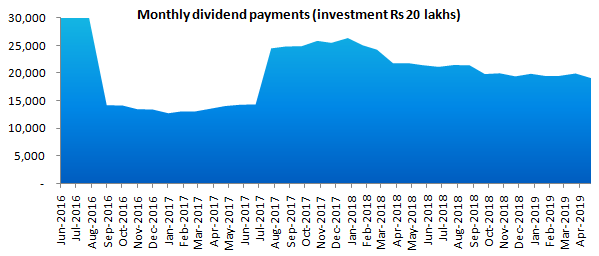Mutual Fund Dividends or SWP: Which is better

Based on our interactions with investors and financial advisors, we see that there is a lot of interest in mutual fund dividends and Systematic Withdrawal Plan (SWP) as income solutions for investors. Many investors prefer dividend options for regular income, but there is a growing interest in SWP in the last few years. In this blog post, we will compare and contrast the two solutions with the help of an actual example. We will also discuss various factors, which can help investors make informed decisions.
What is dividend option?
In Dividend Option the profits made by a scheme are distributed to investors at regular intervals as dividends. SEBI stipulates that dividends can be paid from accumulated profits. Investors should note that, as per SEBI regulations, only realized profits (when portfolio securities are sold at profit) are eligible to be distributed as dividends. Fund managers may not pay the entire profit realized by the scheme during a particular period as dividends. They may retain certain amount of profits in the accumulated profits reserve, so that they can continue to make dividend payments during rainy days (periods in which the scheme does not make profits). It is important for investors to note the following with regards to dividend options:-
- Mutual fund dividends are not assured. They are paid at the discretion of the fund manager / AMC. Schemes which were paying regular dividends can stop paying dividends for an indefinite period of time.
- Mutual fund schemes can reduce or increase dividend payout rate at their discretion – depending on market conditions and outlook.
- There is no fixed day of a month for monthly dividend payments. The AMC decides the day on which dividend will be paid in a particular month or quarter.
- The dividend paid per unit will be stripped from the NAV of the scheme and ex-dividend NAV of the scheme will be net of dividend pay-out.
- Mutual fund dividends are tax free in the hands of the investors, but the AMC has to pay dividend distribution tax (DDT) before paying dividends. The DDT rate is 28.84% for debt mutual funds. In 2018 Budget, the Government introduced 10% DDT for equity or equity oriented mutual funds (prior to FY 2019, dividends paid by equity funds were tax free).
What is SWP or Systematic Withdrawal Plan?
SWP is an investment option offered by mutual funds, whereby investors can draw a fixed amount every month (or any other interval as specified by the AMC) from a mutual fund scheme on a fixed day of any month (or any other interval).
The AMC makes SWP payments to investors by redeeming the required number of units at prevailing NAVs; the balance units remain invested and grow in value with growth in scheme NAV. You can think of SWP as a series of redemptions from your lump sum investment to meet your cash-flow needs. SWP facility registration offers investors the convenience of the AMC taking care of the redemptions on an on-going basis. The biggest advantage of SWP versus dividend option is assurance of fixed cash-flows as long as there is sufficient unit balance. Investors opting for SWP should note the following:-
- Cash-flows will be generated for you by redeeming units of scheme where you have invested. Your unit balance will go down over time.
- If you want more cash-flows, higher number of units will have to be redeemed and your unit balance will be lower and vice versa. You should choose your withdrawal rate carefully.
- You will continue to receive fixed SWP payments irrespective of market conditions, but you should remember that in bear markets more units will have to be redeemed to meet your SWP payments.
- SWP payments made within the exit load period of a scheme will attract requisite charges. Therefore, it is recommended that you begin your SWP after the exit load period.
- SWP payments are subject to capital gains tax. In debt funds capital gains made in units redeemed for SWP within the first 3 years from the date of investment will be taxed as per the income tax rate of the investor. Capital gains (debt funds) made in units redeemed after 3 years from date of investment will be taxed at 20% after allowing for indexation. In equity funds capital gains in units redeemed within 12 months from date of investment will be taxed at 15%. Capital gains in units redeemed after 12 months is tax free, as long as the total capital gains in a financial year do not exceed Rs 1 lakh. Capital gains in excess of Rs 1 lakh in a financial year will be taxed at 10%
Comparing monthly dividend and SWP using an actual example
We will look at two scenarios with the same investment amount in the same scheme but two different options – monthly dividend and monthly SWP from growth option.
Let us assume you invested Rs 20 lakhs in Principal Equity Hybrid Fund on June 1st 2016. In the first case let us assume that you invested in the monthly dividend option of the scheme.

Source: Advisorkhoj Research
You can see that there were variations in your monthly cash-flows. Your monthly dividend was Rs 13,000 – 15,000 in the first few months. Then it rose to around Rs 25,000 per month and later came down to around Rs 20,000. The table summarizes how much you earned from your investment in absolute and monthly terms. Remember dividends are tax free in the hands of the investors; there is no impact of taxes on these figures below.

Your average dividend yield was 12% and your investment value grew by 2.3 lakhs in 3 years, which makes Principal Hybrid Equity Fund an excellent investment. Could you have got better returns with SWP?
In the second case let us assume you invested the same amount (Rs 20 lakhs) in the growth option of Principal Equity Hybrid Fund. For the purpose of comparison, let us assume that you draw Rs 19,300 (almost the same amount as your average monthly dividend in the previous case) every month through monthly SWP. The chart below shows you much you would have withdrawn on a cumulative basis and the market value of your investment over time.

Source: Advisorkhoj Research
Your cumulative withdrawal was Rs 6.95 lakhs (as in the previous case). However, you current investment value is Rs 22.6 lakhs; Rs 30,000 higher than the dividend example. The table below summarizes the result

Impact of capital gains tax
In the SWP example above, taxes were not considered. However, the analysis would not be complete if we ignore taxes. The table below shows the capital gains made on account of redemptions for each financial year through the SWP period so period.

Capital Gains made in FY 2017 would be subject to 15%, short term capital gains (STCG) tax. STCG tax payable in FY 2017 was Rs 2,824. In FY 2018, only Rs 7,642 capital gains would be subject to STCG, the balance is long term capital gains (LTCG).
As long as LTCG is less than Rs 1 lakh in a financial year, it is tax free. Capital gains in FY 2019 and YTD 2020 are less than Rs 1 lakh and hence tax free. The total tax liability of the investor in this period is less than Rs 4,000. Therefore, even after paying capital gains tax, SWP gave higher returns than the dividend option. Investors can reduce their tax obligation even further by beginning their SWP 12 months after the date of investment.
Suggested reading: Regular Withdrawal Plan – A smart and convenient way of getting regular income
At some point of time in the future, LTCG in this SWP will exceed Rs 1 lakh and 10% LTCG tax for profits in excess of Rs 1 lakh will come into play. However, investors should remember that then finance minister in his 2018 Budget speech allowed grandfathering of long term capital gains for investments made before January 31st 2018. This means that, for the purpose of long term capital gains calculation, the purchase cost of units (purchase NAV) can be adjusted to reflect NAVs on January 31st 2018. Investors should keep this is in mind as this will reduce their long term capital gains tax obligation.
Why was SWP able to give better returns?
Long term capital gains tax up to Rs 1 lakh in a financial year is tax free, whereas the entire dividend amount is subject to 10% DDT. The beneficial tax treatment of long term capital gains versus DDT makes SWP a more attractive investment
Is SWP always better than dividends?
SWP can be better or worse than dividend option, depending on the decisions made by the investor. If the SWP withdrawal rate is reasonably low, then in the long term SWP can give superior post tax returns. However, if the SWP withdrawal rate is too high then the units will diminish at a faster rate and the investor runs the risk of running out of funds. Ideally, the SWP withdrawal rate should be lower than the average long term ROI of the scheme. While SWP gives investors the convenience of fixed regular cash-flows, investors should also be flexible about reducing their withdrawal rates in severe market conditions (e.g. severe bear market lasting for several quarters).
Conclusion
In this blog post, we compared dividend option with SWP with an actual example. SWP gives the comfort of predictable cash-flows and superior post tax returns over long tenures. In our view, dividend option is more suitable for new or less experienced investors. Unlike dividends, SWP gives power to the investor to decide cash-flows. However, this power can be a double edged sword and therefore, must be exercised with caution – investor’s withdrawal rates should be reasonably low, so that they can create wealth in the long term. Financial advisors recommend maximum 7 – 8% p.a. withdrawal rates in SWP. In our SWP example, the withdrawal rate was much higher (in double digits) and still SWP worked quite well. While your SWP will be depend on your financial needs, a lower SWP rate is more advisable. Investors should consult with their financial advisors about the suitability of SWP for their income needs.
Mutual Fund Investments are subject to market risk, read all scheme related documents carefully.
Queries
-
What is the benefit of mutual fund STP
Aug 29, 2019
-
How much to invest to meet target amount of Rs 2 Crores
Aug 26, 2019
-
Can I achieve my financial goals with my current mutual fund investments
Aug 24, 2019
-
Can you tell me return of various indices
Aug 19, 2019
-
What would be the post tax return on different investments
Aug 18, 2019
-
Which Principal Mutual Fund scheme will be suitable for my retirement corpus
Aug 16, 2019
-
What is the minimum holding period for availing NCD interest
Aug 4, 2019
Top Performing Mutual Funds
Recommended Reading
Fund News
-
Zerodha Mutual Fund launches Zerodha Nifty Short Duration G Sec Index Fund
Dec 26, 2025 by Advisorkhoj Team
-
Groww Mutual Fund launches Groww Nifty Chemicals ETF
Dec 26, 2025 by Advisorkhoj Team
-
DSP Mutual Fund launches DSP Nifty Next 50 ETF
Dec 19, 2025 by Advisorkhoj Team
-
DSP Mutual Fund launches DSP Nifty 500 Index Fund
Dec 19, 2025 by Advisorkhoj Team
-
Kotak Mahindra Mutual Fund launches Kotak Nifty Next 50 ETF
Dec 18, 2025 by Advisorkhoj Team














